Pichhwai also known as pichhavai, pichhvai, pechhavai etc. are large devotional Hindu painted pictures, normally on cloth, which portray Krishna. They are mainly made to hang in Hindu temples of the Pushtimarg devotional tradition, especially the Shrinathji Temple in Nathdwara, Rajasthan, built around 1672. They are hung behind the idol of Shrinathji, a local form of Krishna and the centre of Pushtimarg worship, to depict his leelas.
Aurangabad was another area associated with them. The purpose of Pichhwais, other than artistic appeal, is to narrate tales of Krishna to the illiterate. Temples have sets with different images, which are changed according to the calendar of festivals celebrating the deity. The word Pichhwai stands for hanging at the back (Sanskrit word "Pichh" means back and "wais" means hanging).
In the late 16th century, the artists started creating pictorial illustrations on cloth and hanging on the wall to decorate the temples of Shrinathji, and this resulted in the birth of pichwai paintings. Nathdwara painting covers these and similar works in other genres, especially Indian miniature paintings. The Pushtimarg tradition, they originated in the Deccan, but are now mainly associated with Western India.
Pichhwai have become the main export of Nathdwara and are in much demand among foreign visitors. The artists live mostly in Chitron ki gali (Street of paintings) and Chitrakaron ka mohallah (colony of painters) and make a close community with constant interaction. Often a Pichhwai painting is a group effort, where several skilful painters work together under the supervision of a master artist.
A typical Pichwai has 24 boxes around called Swaroops. Each of them has a Krishna, Gopis and various other elements. The elaborate Shringar of Shrinathji is captivating. There is so much that happens in Pichwai and yet it doesn't feel crowded. Despite having various figurines and elements in it Pichwai is a sheer example of Aesthetic balance and beauty. The colors and the vibrancy of the Pichwai are its beauty. The touch of vibrant natural colors on the fabric or paper give out a certain kind of romance that speaks for itself.
To make Pichwai prominent for today, the artist has contemporized the artform without compromising its traditional touch. Pichwais traditionally was expansive as they were hung behind the deity but as time passed by the size of the paintings started reducing. Also, the colors are no longer pure organic. Due to the budget and time constraints and the unavailability of natural dyes, artists now use either synthetic or the mixture of synthetic and natural colors. The paper is used as an alternative instead of cotton fabric. A Pichwai now belongs everywhere. Because of their beauty and brilliance. Pichwais are now also hung on house walls and other places and are no longer restricted to the temples.





